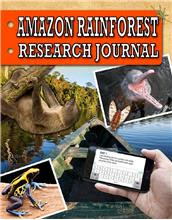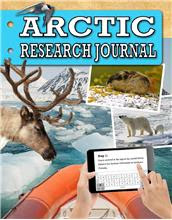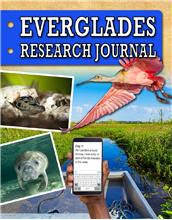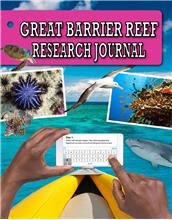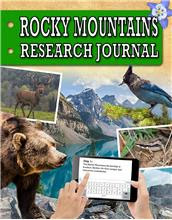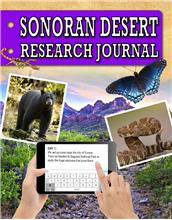| ________________
CM . . . . Volume XXIV Number 34. . . . May 4, 2018
excerpt:
The “Ecosystems Research Journal” series is a prime example of an unsatisfactory product. Each 32-page volume is presented as if it were the journal of a (presumably) young, eager scientist who has been asked (by a fictitious organization) to join an expedition to the specified ecosystem. It is unclear what qualifications each narrator possesses and why they have been asked to participate in the journey. Nor is there often mention of any fellow members of the expedition. Nor does any actual research take place. All of the journals last 11 days, except the Arctic journal which lasts 30 (though not all days are documented). Only some of the volumes openly acknowledge that the narrator is fictional. The pages of the books are presented as field journals of a day. These are displayed as if they were being composed on a tablet, a conceit that takes up space that could be better filled with information. Photographs, charts, paper-notebook pages (field notes), status reports, etc. are scattered across the page as if on the narrator’s desk. Unfortunately, the cluttered boxes do not provide enough space for meaningful information. Due to the small page format, maps, charts, graphs, and photos are sometimes too small to be genuinely useful. Graphs are often inaccurate in their proportions. Photos are stock and often noticeably photoshopped. The purpose of the books is unclear. Are the publishers trying to provide information on various ecosystems, or are they trying to acquaint students with the concept of field notes, journals, and reports? In either case, they are unsuccessful. Note: Two interesting sources for the keeping of field notes and journals are: Keeping a Field Journal, https://yellowstonenaturalist.com Keeping a Naturalist’s Field Journal, https://pages.wustl.edu>files>imc>mnh Amazon Research Journal The narrative is confused. The narrator arrives at Iquitos, Peru, goes up river by bus to Nauta and then returns to Iquitos by river without acknowledging it was her starting point. (I will use “she” and “her” in referring to the narrator/researcher because the six books being reviewed have female authors, and it appears to be a conceit of the series that the author is the researcher.) Later, she takes some side trips about midway down the river but doesn’t specify her location, not that there is a map we could easily consult. She refers to encountering mangroves two days before the junction of Rio Negro and Rio Solimões, which I questioned, as mangroves are a coastal phenomenon. This trip from the source of the Amazon to the mouth lasts only 11 days, hardly time to do “research” along 7000 kilometres of river. At best, this could be called eco-tourism … or a junket by a PR flack. Arctic Research Journal On p. 23, a picture of a moose’s head is overlaid on a picture (which is small and difficult to see in detail) of caribou on the tundra. But while muskoxen live on the tundra, moose are boreal (forest) dwellers. As an example of lack of care in production, enough said. In the glossary, the definition of keystone species--“a species that keeps the populations of other species under control”--is so simplified as to give a false impression of the concept. This definition is closer to the definition of apex species or apex predator. From Wikipedia: A keystone species is a species that has a disproportionately large effect on its environment relative to its abundance.[1] Everglades Research Journal At least, this gender neutral narrator indicates her guide is a female. My questioning nature having been aroused, I still tend to doubt everything. On p. 24, a photo of a hardwood hammock shows nothing but palm trees. Could a more representative picture be found? Great Barrier Reef Research Journal So I have a bee in my bonnet about mangroves. In this volume, p.18 states “Mangroves are flooded forests of trees.” From Wikipedia “Mangroves are salt-tolerant trees, also called halophytes, and are adapted to life in harsh coastal conditions.” So, not any tree will do. Also, on p. 19, in a discussion of the importance of crabs to mangroves and salt marshes, the author states “Crabs also increase the oxygen in the water.” On a third careful reading of the paragraph and some confirming research, I realize that, if you connect this sentence to the next with “because” you may have an accurate statement. “Crabs also increase the oxygen in the water, [because] pockets of air get trapped in their burrows.” Only simple sentences seem to be allowed. Rocky Mountain Research Journal On the first page of text, next to a map of the region, the author states: “The mountains stretch along the western coast of Canada and the United States.” I’m sure the residents of western Alberta, Idaho, Montana, Wyoming, Colorado, and Utah will be surprised to learn that they live on the coast. On p. 14, the “Sightings” block states, “I saw a flock of snow geese,” but what is pictured is a Canada goose. On p. 23, a “status report” on a Half-moon hairstreak butterfly describes it as having brownish black wings with black spots. The photo chosen shows a yellowish green butterfly. The text on p. 25 completes a discussion of pine beetle infestation of lodge pole pines and moves on to discuss chronic wasting disease in deer. The bottom half of the page has a chart of numbers of deer with chronic wasting disease and a photo of a tree with rusty red needles captioned, “Chronic wasting disease turns trees rust-red.” The Status Report of Stone Sheep on p. 27 states it is a “tinhorn” sheep; that should, of course, be “thinhorn sheep” (Ovis dalli)--as opposed to “bighorn sheep” (Ovis canadensis) Sonoran Desert Research Journal This volume has some of the worst examples of photoshopping: p. 14 a bobwhite quail obviously added to grasslands of different proportion, p.20 both the great horned owl and the wood rat seem added to the picture, and p.24 where an off-road vehicle and creosote bush are added to a sand-dune scene. There is also a photo of “Mexican giant cardoons … the tallest cactuses in the world” (p. 22), but there is nothing in the picture to indicate the scale of the cactus and no height is given. Also pictured on the same page are Boojum trees which look weird and interesting. They are also mentioned in the text, but with no explanation of what they are, why they look like that, or what their place in the ecosystem might be. The more closely you read these books, the more flaws are revealed in terms of errors, misleading charts, etc. It is a shame because some interesting topic such UNESCO’s World Biosphere Reserves, in which sustainable development is being studied, are mentioned once and not explored. The long and the short of it is: do not buy these books. Not Recommended. Rebecca King, now retired, was the Library Support Specialist for the Halifax Regional School Board.
Next Review |
Table of Contents for This Issue
- May 4, 2018. |
